 The HGST Travelstar 7K1000 is a 1TB, 7,200RPM HDD that comes in a 2.5″, 9.5mm form factor and interfaces over SATA 6Gb/s. The Travelstar 7K1000 is fairly unique in the space. Many drives are migrating to slimmer z-Heights at 7mm or even 5mm to meet the needs of space-constrained applications such as upgrading HDDs in ultrabooks. However, the 7K1000’s target is a larger market – consumers that require robust capacity in their notebook computer or small form factor desktop at an economical price. Matching well with notebooks, the drive also features low power consumption and the highest shock tolerance in the industry. The 7K1000 also leverages Advanced Format which increased the physical sector size from 512 to 4096 bytes (4k). This helps to improve capacity and error correction capabilities.
The HGST Travelstar 7K1000 is a 1TB, 7,200RPM HDD that comes in a 2.5″, 9.5mm form factor and interfaces over SATA 6Gb/s. The Travelstar 7K1000 is fairly unique in the space. Many drives are migrating to slimmer z-Heights at 7mm or even 5mm to meet the needs of space-constrained applications such as upgrading HDDs in ultrabooks. However, the 7K1000’s target is a larger market – consumers that require robust capacity in their notebook computer or small form factor desktop at an economical price. Matching well with notebooks, the drive also features low power consumption and the highest shock tolerance in the industry. The 7K1000 also leverages Advanced Format which increased the physical sector size from 512 to 4096 bytes (4k). This helps to improve capacity and error correction capabilities.
The HGST Travelstar 7K1000 is a 1TB, 7,200RPM HDD that comes in a 2.5″, 9.5mm form factor and interfaces over SATA 6Gb/s. The Travelstar 7K1000 is fairly unique in the space. Many drives are migrating to slimmer z-Heights at 7mm or even 5mm to meet the needs of space-constrained applications such as upgrading HDDs in ultrabooks. However, the 7K1000’s target is a larger market – consumers that require robust capacity in their notebook computer or small form factor desktop at an economical price. Matching well with notebooks, the drive also features low power consumption and the highest shock tolerance in the industry. The 7K1000 also leverages Advanced Format which increased the physical sector size from 512 to 4096 bytes (4k). This helps to improve capacity and error correction capabilities.
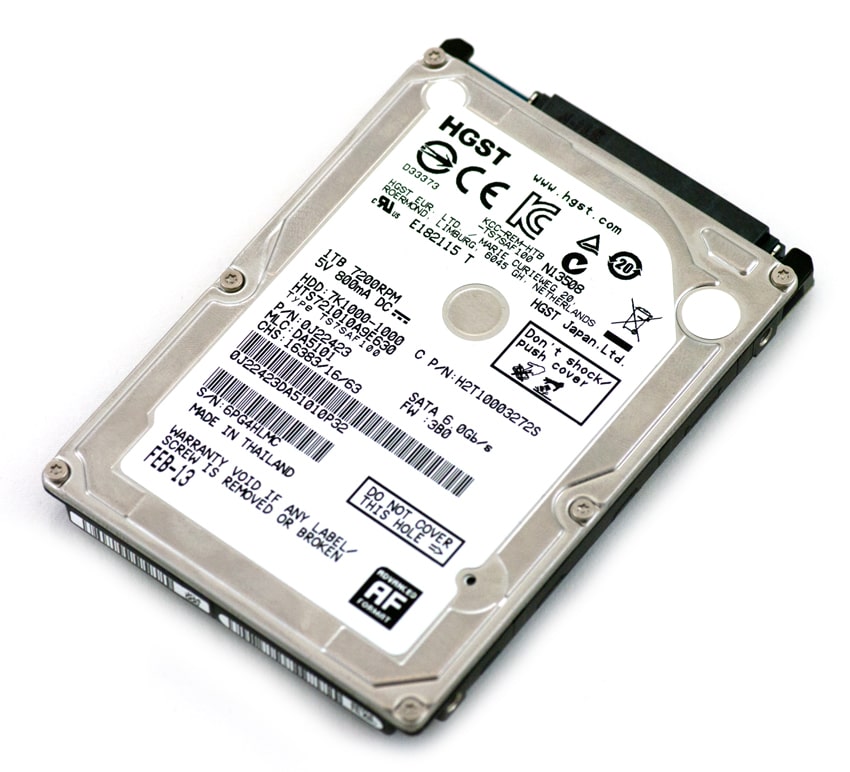
HGST has not only chosen to stick with the 9.5mm z-Height in order to provide a maximum capacity of 1TB, but they are also maintaining a spindle speed of 7,200RPM in their seventh-generation drive. This marks a divergence; where other HDD manufacturers are starting to or already have swapped out their 7,200RPM drives for 5,400RPM models for the gained benefits of lowered power and noise, HGST is continuing to implement the 7,200RPM spin speed to target higher performance with the Travelstar 7K1000.
The HGST 7K1000 has a street price of $88.99.
HGST Travelstar 7K1000 HDD Specifications
- Capacity: 1TB (HTS721010A9E630)
- Interface: SATA 6Gb/s
- Sector size (variable, Bytes/sector) 512e
- Recording zones 30
- Max areal density (Gbits/sq. in.) 676
- Performance
- 32MB data buffer
- 7,200 RPM
- Latency Average: 4.2ms
- Media transfer rate (Mbits/sec, max): 1284
- Seek time: Average (typical)ms(read): 12
- Seek time: Track to track (typical)ms(read): 1
- Seek time: Full Stroke (typical)ms(read): 20
- Performance: Load/Unload Cycles 600,000
- Power
- Requirement: Start-up (W, peak, max) 5.5
- Requirement: Read/Write (W, avg) 1.8
- Requirement: Low power idle (W, avg) 0.8
- Requirement: Standby (W, avg) 0.2
- Dissipation: Seek (W, Avg) 2.1
- Dissipation: Active Idle (W, Avg) 1.0
- Performance Idle 1.7
- Sleep (W) 0.1
- Environmental
- Operating temperature: 0° to 60°C
- Non-operating temperature: -40° to 65°C
- Operating Shock half-sine wave: 400G/2ms, 225G/1ms
- Non-operating Shock half-sine wave: 1000G/1ms
- Acoustics (dBA): Idle: 2.5, Seek: 2.7
- Dimensions (WxDxH): 70mm x 100mm x 9.5mm
- Weight (max): 115g
Design and Build
The HGST Travelstar 7K1000 HDD has a simple, condensed design to fit the robust 1TB capacity into a 9.5mm form factor. The cover of the 7K1000 is silver, while the body is black and the underside is composed primarily of the circuit board. The cover features an HGST product information label that spreads nearly the entire width of the drive and includes information about the model, capacity, etc. The top cover is held on by six visible screws. The sides of the HGST Travelstar 7K1000 feature the four screw holes that enable simple, proper mounting. On the rear of the drive, we find the connectors for power and SATA.
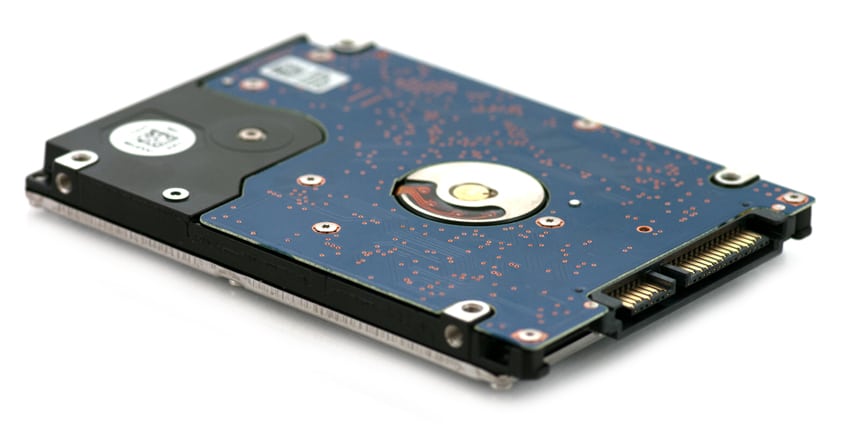
Eight small screws affix the circuit board to the hard drive body securely. Underneath, there are thermal pads to keep the drive from overheating. The circuit board features a Marvell 88i9305 controller chip and 32MB of cache from the EtronTech DRAM. Internally, there are 2 platters at 500GB each for a total of 1TB in capacity.
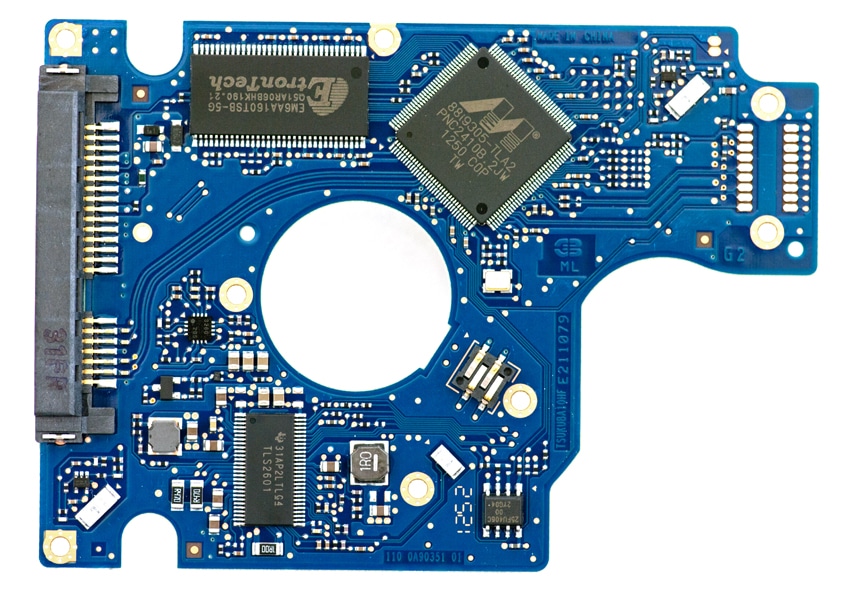
Performance and Synthetic Benchmarks
When it comes to measuring performance of the HGST Travelstar 7K1000 the two categories of benchmarks that we commonly test all consumer HDDs and SSDs on show strengths in different areas. Our synthetic benchmarks are geared at showing the performance of the drive in an uncached “worst case” scenario, while our real-world traces allow the drive to cache data and better show how the drive would perform during repetitive day-to-day activities.
Benchmarking comparables for this review:
- Western Digital Scorpio Black (750GB, 4K)
- Seagate Momentus XT (750GB, 4K, 8GB SLC NAND)
- Hitachi Travelstar 7K500 (500GB)
- Seagate Momentus XT (500GB, 4GB SLC NAND)
- Western Digital Scorpio Black (500GB)
- Western Digital Scorpio Black (320GB)
- Seagate Momentus XT (750GB, 8GB SLC NAND)
- Seagate SSHD Thin (500GB, 8GB MLC NAND)
Using our Consumer Testing Platform, we measured 2MB Sequential speeds, and the HGST Travelstar 7K1000 1TB came in at 123.56MB/s read and 122.46MB/s write. The read figure was just barely edged out by the WD Scorpio Black 750GB 4k, while the write figure was class-best.
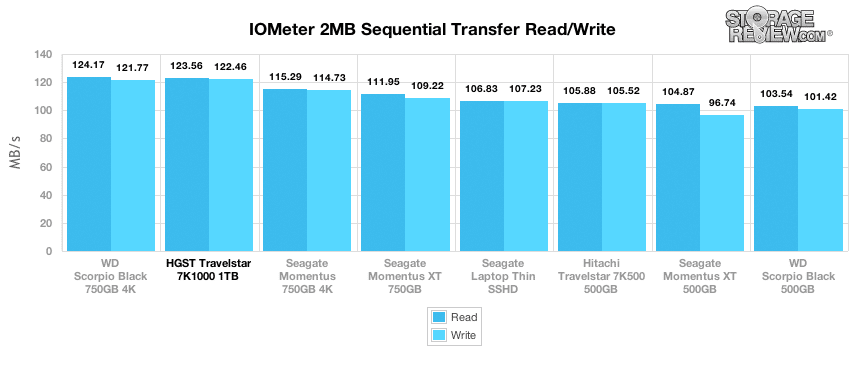
For the 2MB Random Transfer testing, the HGST Travelstar 7K1000 came in at 50.63MB/s read and 57.49MB/s write, placing it in the middle of the group. The read activity was near the middle of the group, while the write activity was near the upper-middle of the group.
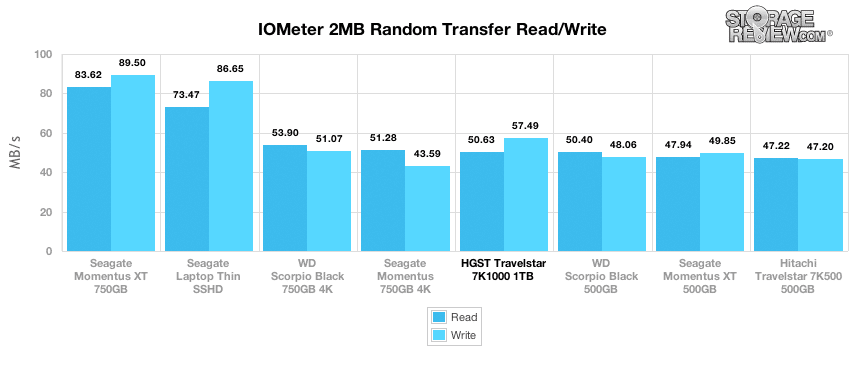
In the 4k Random Transfers MB/s, the HGST Travelstar 7K1000 performed near the middle of the group at 0.252MB/s read and near the lower end of the group with 0.506MB/s write. The HGST Travelstar 7K1000 ranked near the middle of the group for throughput at 64.57 IOPS read and 129.58 IOPS write.
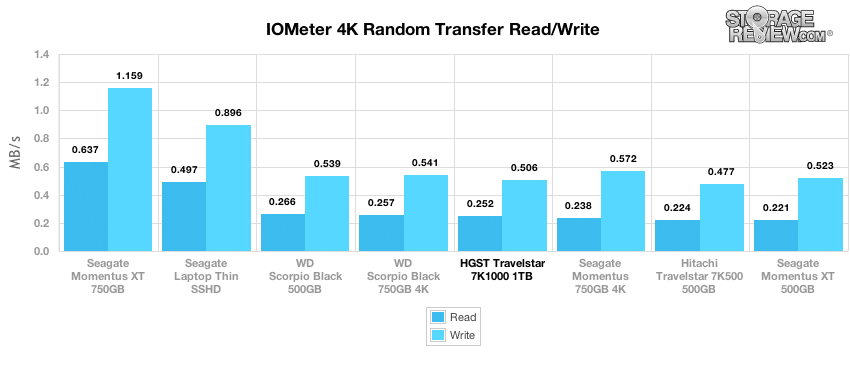
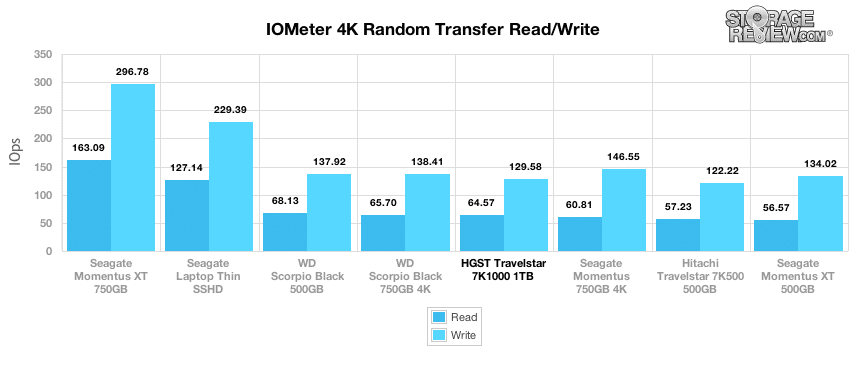
In our 4k Write Latency, the HGST Travelstar 7K1000 posted an Average 4k Write Latency of 7.72ms which was second from the bottom, with a Max 4k Write Latency at 19.11ms, which was a class-leading figure.
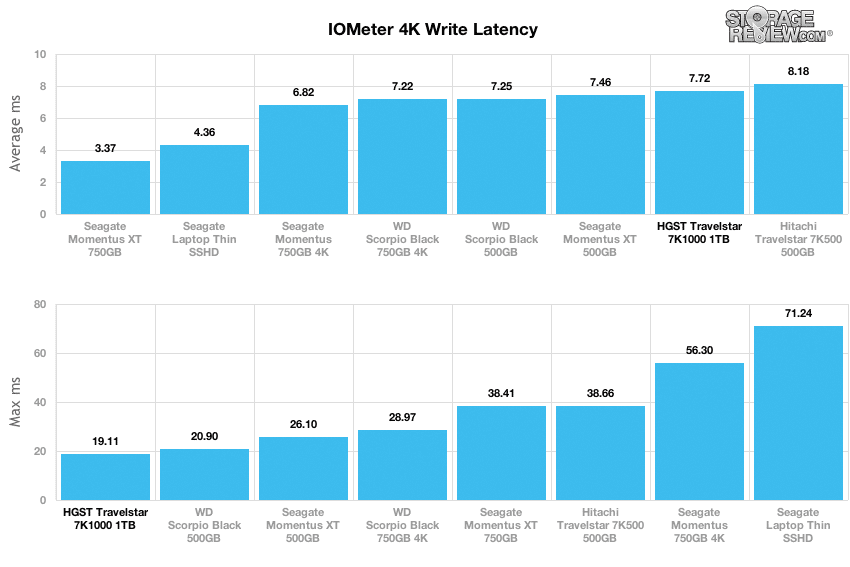
Our last series of synthetic benchmarks compares the hard drives in a series of server mixed-workloads with a queue depth of ranging from 1 to 128. Each of our server profile tests has a strong preference towards read activity, ranging from 67% read with our database profile to 100% read in our web server profile. In all of our mixed workloads, the HGST Travelstar 7K1000 performed near the lower end of the group.
The first test is our database profile, with a 67% read and 33% write workload mix primarily centered on 8k transfer sizes. Our Database profile showed the HGST Travelstar 7K1000 performing near the bottom of the group, ranging up from 76-128 IOPS.
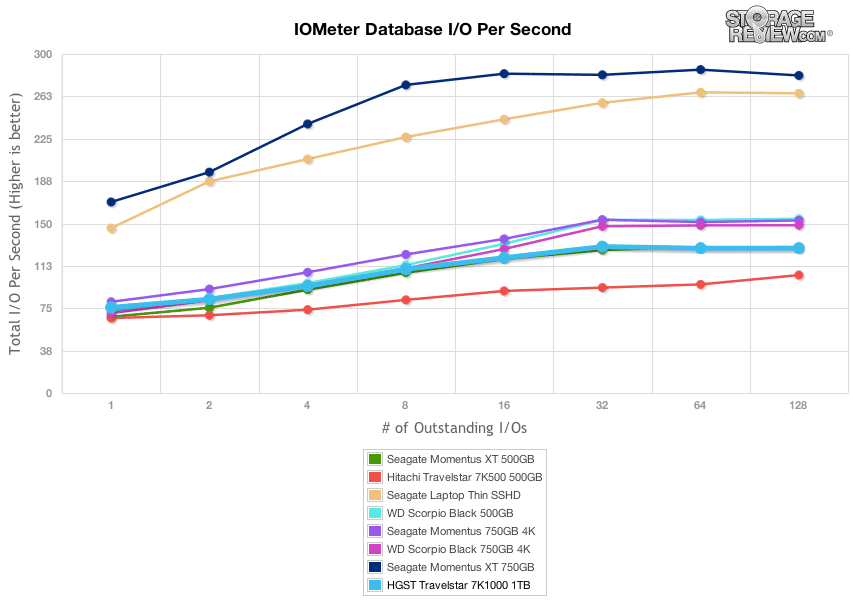
The next profile looks at a file server, with 80% read and 20% write workload spread out over multiple transfer sizes ranging from 512-byte to 64KB. In the File Server profile, the HGST Travelstar 7K1000 again performed near the lower end of the tested drive with a peak of 120 IOPS.
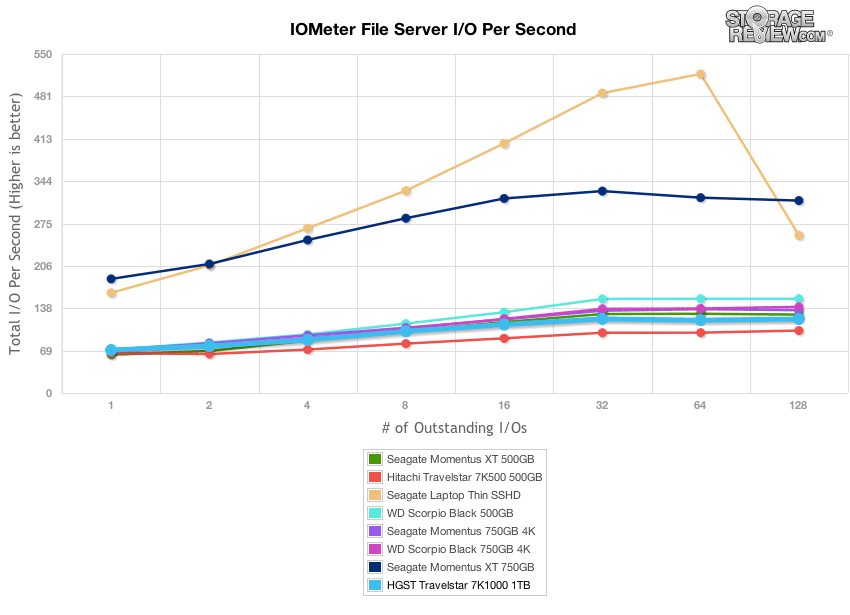
Our web server profile is read-only with a spread of transfer sizes from 512-byte to 512KB. The HGST Travelstar 7K1000 tested just ahead of the Seagate Momentus XT 500GB. This time, the Travelstar 7K1000 reached 122 IOPS before steadying at 120 IOPS.
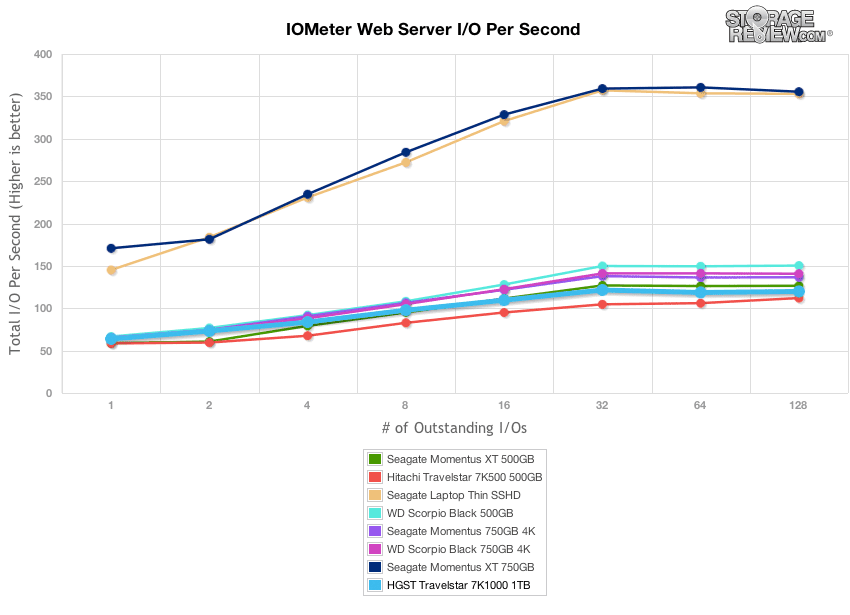
The last profile looks at a workstation, with a 20% write and 80% read mixture using 8k transfers. Here again, the HGST Travelstar 7K1000 stayed near the bottom of the group at about 128 IOPS.
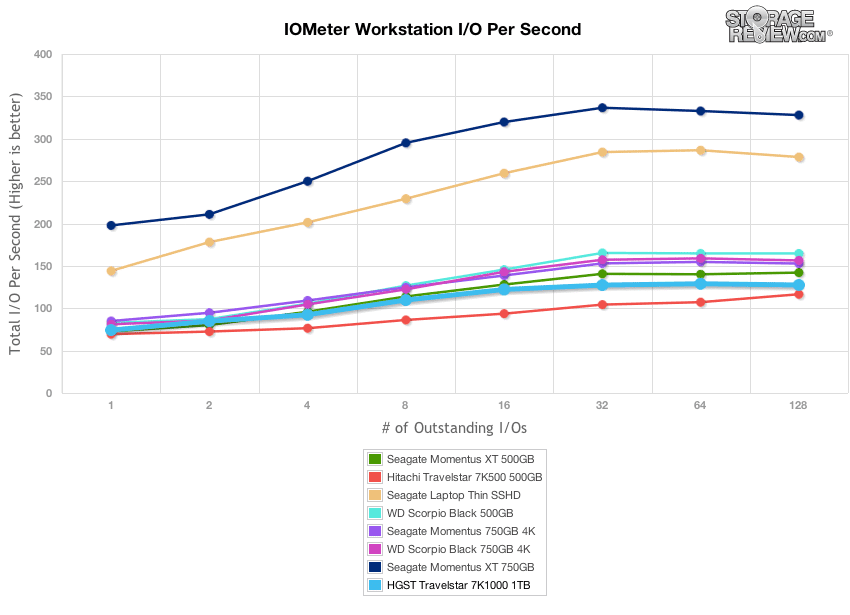
Consumer Real-World Benchmarks
For the average consumer, trying to translate random 4K write speeds into an everyday situation is pretty difficult. It helps when comparing drives in every setting possible, but it doesn’t exactly work out into faster everyday usage or better game loading times. For this reason we turned to our StorageMark 2010 traces, which include HTPC and Gaming traces to help readers find out how a drive might rank under their conditions.
The first real-life test is our HTPC scenario. In this test we include: playing one 720P HD movie in Media Player Classic, one 480P SD movie playing in VLC, three movies downloading simultaneously through iTunes, and one 1080i HDTV stream being recorded through Windows Media Center over a 15 minute period. Higher IOPS and MB/s rates with lower latency times are preferred. In this trace we recorded 2,986MB being written to the drive and 1,924MB being read.
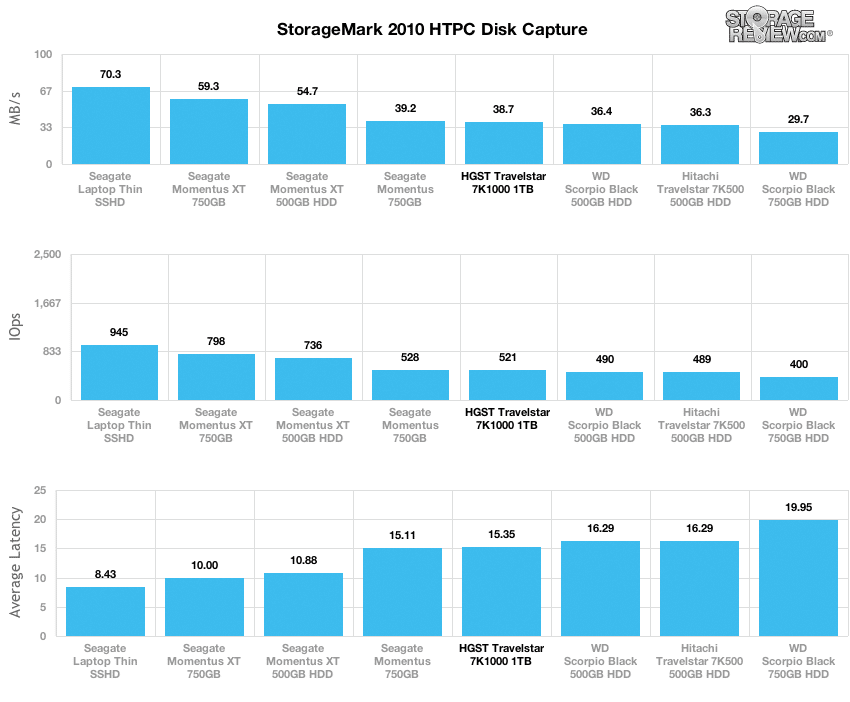
In the StorageMark2010 HTPC 4k Disk Capture, the HGST Travelstar 7K1000 offered 520 IOPS, 38.72MB/s and an average latency of 15.35ms. The latency was near the bottom of the group, but the other two figures were near the middle.
Our other real-life test covers disk activity in a gaming environment. Unlike the HTPC trace, this one relies heavily on the read performance of a drive. To give a simple breakdown of read/write percentages, the HTPC test is 64% write, 36% read, and the gaming trace is 6% write and 94% read. The test consists of a Windows 7 Ultimate 64-bit system pre-configured with Steam, with Grand Theft Auto 4, Left 4 Dead 2, and Mass Effect 2 already downloaded and installed. The trace captures the heavy read activity of each game loading from the start, as well as textures as the game progresses. In this trace we recorded 426MB being written to the drive and 7,235MB being read.
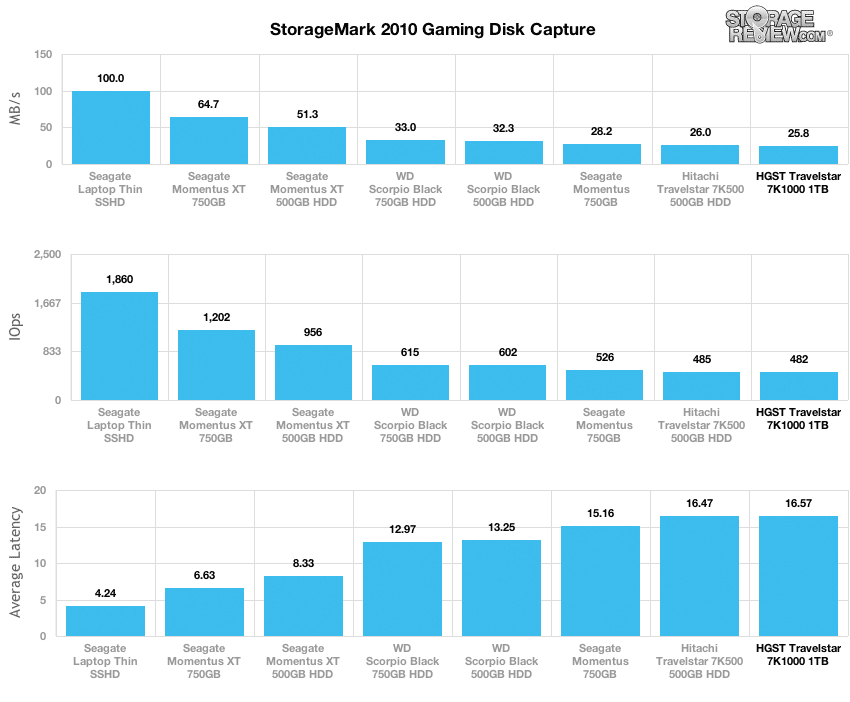
In the StorageMark 2010 Gaming Mark Capture, the HGST Travelstar 7K1000 produced the highest latency and the lowest performance amongst the comparables. Latency measured 16.57ms, while the drive produced 482 IOPS and 25.83MB/s.
Power Consumption
With any laptop drive, power consumption is an important factor. The key sources of power draw get narrowed down to either the bright screen or the storage device used. In the next test, we record the average power consumed over a small range of synthetic benchmarks. For reference, HGST lists an idle power rate ranging from 0.8-1.7W and an active seek rate of 2.1W.

HGST’s provided power values came decently close to the data we collected from our tests. Our actual idle rate measured at 0.9W. Active power values ranged from 3 to 2.62W. The highest power values were found with reads at 3W. The idle power we measured was very close to the low-end of the quoted HGST figure while active power also just a tiny bit higher. Startup power requirements measured well under HGST’s max quote at just 4.24W to get the drive up to operating speed.
Conclusion
What makes the HGST Travelstar 7K1000 unique is that it features 1TB in a fairly slim 2.5″, 9.5mm form factor, good enough to fit into notebook computers. The 7K1000 hasn’t been narrowed enough to fit into ultrabooks, but with its two 500GB platters for 1TB total, users gain enhanced native capacity from their system. The 7K1000 also spins at 7,200RPM instead of the 5,400RPM that many drives in the space now feature, and it does so with a standard SATA 6Gb/s interface. To further optimize it for notebook computers, HGST engineered the drive to require very little power and also to have the rigidity to stand up to bumps that often happen in transit as the drive has the highest shock tolerance in the industry.
Some of the class comparables used in testing the HGST Travelstar 7K1000 are more traditional HDDs while others belong to the emerging group of SSHDs that incorporate spinning disk drives with NAND packages to enhance performance. That alone created some disparity which should be taken into consideration, though a 1TB SSHD only runs about $20 more than the 7K1000. While the drives primarily target the notebook-upgrade market for greater capacity and/or performance, the Travelstar 7K1000 and the Seagate SSHD come in capacities up to 1TB. That in itself makes those drives unique.
For more specifics related to the testing, in our sever profiles, which are all read-intensive testing environments, the HGST Travelstar 7K1000 often fell near the lower-middle of the group, edging out a couple of drives. The same was true of the Travelstar 7K1000’s performance in our real-world testing environments. However, the 7K1000 also had some areas where it shined. It performed really well in our 2MB sequential testing for both read and write activity. The 7K1000 also provided a very low max 4k write latency, though its average 4k write latency was higher. Another significant area in which the 7K1000 performed well was in power consumption. In a couple of categories, the drive performed with the same or less energy than the quoted figures, which is obviously a big advantage in the notebook computer upgrades segment for which the 7K1000 is intended.
Pros
- 1TB in 9.5mm form factor
- Low power consumption
- High throughput in 2MB sequential testing
Cons
- Lower read-intensive server profile performance
- Middle of group performance throughout the bulk of testing
Bottom Line
Users looking to upgrade existing notebook computer drives with a much higher capacity HDD that requires very level power to operate will the HGST Travelstar 7K1000 to be a favorable choice.
HGST Travelstar 7K1000 at Amazon.com
